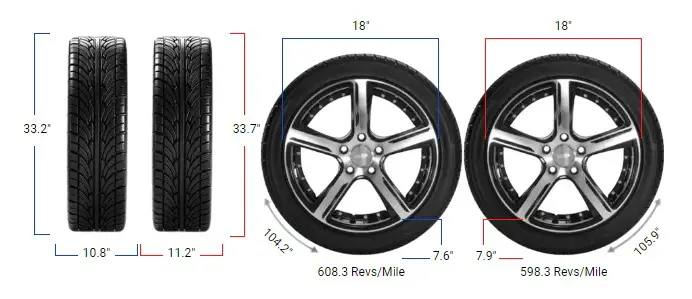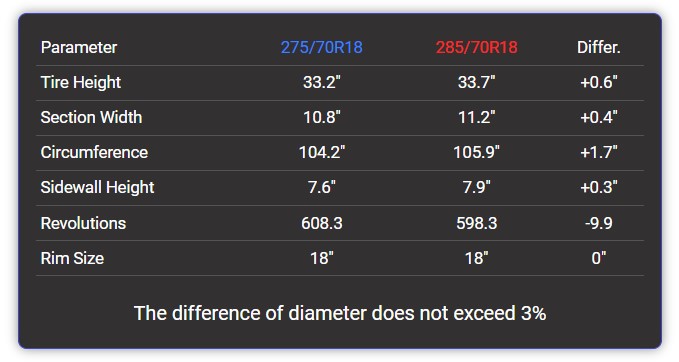Tire Size 275/70r18 vs 285/70r18
 Switching from 275/70r18 to 285/75r18 tires involves a significant change in overall diameter, exceeding the recommended 3% range. This switch results in a 5% increase in diameter, which can affect vehicle performance, handling, and safety.
Switching from 275/70r18 to 285/75r18 tires involves a significant change in overall diameter, exceeding the recommended 3% range. This switch results in a 5% increase in diameter, which can affect vehicle performance, handling, and safety.
While it may offer some benefits for off-road use, it also comes with potential drawbacks that drivers should carefully consider before making the change.
- Larger tires can improve ground clearance and off-road capability.
- Speedometer accuracy will be affected, showing slower speeds than actual.
- Fuel economy may decrease due to increased rolling resistance.
- Potential rubbing and clearance issues may require vehicle modifications.
275/70r18 vs 285/70r18 Table

The primary distinction between 275/70r18 and 285/75r18 tires lies in their overall diameter. The 285/75r18 tire is 1.67 inches (42.5 mm) larger in diameter, which translates to a 5% increase.
This seemingly small difference can have notable impacts on various aspects of vehicle performance, from ground clearance to fuel efficiency.
Fitment Guide
The general rule of thumb is that replacement tires should be within plus or minus 3% of the original tire’s overall diameter.
In this case, the switch from 275/70r18 to 285/75r18 results in a 5% increase, which exceeds the recommended range. This means the interchange is not typically recommended without making necessary adaptations to the vehicle.
On-Road Impact
Switching to larger tires can have several effects on your vehicle’s on-road performance:
- Speedometer Accuracy: With the 5% increase in tire diameter, your speedometer will read slower than your actual speed. For example, when your speedometer shows 20 mph, you’ll actually be traveling at 21.01 mph. This discrepancy can lead to unintentional speeding.
- Fuel Economy: Larger tires generally have more rolling resistance, which can negatively impact fuel efficiency. The 285/75r18 tires may cause a slight decrease in your vehicle’s miles per gallon.
- Acceleration: The increased weight and diameter of the larger tires can result in slightly slower acceleration, as the engine needs to work harder to turn the wheels.
- Braking Distance: Larger, heavier tires can increase braking distances, potentially affecting safety in emergency situations.
- Ride Comfort: The taller sidewall of the 285/75r18 tires (8.42 inches compared to 7.58 inches) might provide a slightly smoother ride over bumps and rough roads.
Off-Road Impact
For off-road enthusiasts, the switch to 285/75r18 tires can offer some advantages:
- Ground Clearance: The larger diameter provides an additional 0.835 inches (half of 1.67 inches) of ground clearance, which can be beneficial when navigating rough terrain or obstacles.
- Traction: The wider tread (11.22 inches vs. 10.83 inches) of the 285/75r18 tires can provide improved traction in loose or muddy conditions.
- Flotation: Larger tires generally perform better in soft surfaces like sand or snow, as they distribute the vehicle’s weight over a larger area.
- Aesthetic Appeal: Many off-road enthusiasts prefer the look of larger tires, which can give the vehicle a more aggressive appearance.
Potential Challenges
While there are benefits to switching to larger tires, it’s important to consider the potential challenges:
- Rubbing and Clearance Issues: The increased size may cause the tires to rub against the fenders, wheel wells, or suspension components, especially during turns or when the suspension is compressed.
- Strain on Drivetrain: Larger, heavier tires put additional stress on your vehicle’s engine, transmission, and axles, potentially leading to increased wear and tear.
- Handling Changes: The change in tire size can affect your vehicle’s handling characteristics, potentially making it feel less responsive or stable in certain situations.
Our Observation
Switching from 275/70r18 to 285/75r18 tires offers a mix of benefits and drawbacks. The increased ground clearance and improved off-road capability are significant advantages for those who frequently venture off the beaten path.
However, the impact on speedometer accuracy, potential fuel economy decrease, and possible need for vehicle modifications are important considerations. For on-road use, the differences in handling and performance may be noticeable but not drastic.
Off-road, the larger tires can provide a meaningful improvement in capability. Ultimately, the decision depends on your specific needs and willingness to address potential issues.
If you prioritize off-road performance and are prepared to make necessary adjustments, the switch could be worthwhile. However, for primarily on-road use, the potential drawbacks may outweigh the benefits.
Will switching to 285/75r18 tires void my vehicle’s warranty?
A: It might affect certain aspects of your warranty. Check with your vehicle manufacturer or dealer for specific details.
Do I need to recalibrate my speedometer after switching to larger tires?
A: Yes, it’s recommended to recalibrate your speedometer to ensure accuracy with the new tire size.
Can I switch to 285/75r18 tires without lifting my vehicle?
A: It depends on your vehicle model. Some may accommodate the larger size without a lift, while others may require modifications to prevent rubbing.
How will the larger tires affect my vehicle’s turning radius?
A: The larger tires may slightly increase your turning radius, making tight turns a bit more challenging.
Will the switch to larger tires affect my vehicle’s ABS or traction control systems?
A: The change in tire size can potentially impact these systems. It’s best to consult with a professional to ensure proper functionality.
Related Article

Meet Caitlin McCormack, a Tire Size Expert and Blogger Passionate About Everything Related to Tires. With Years of Experience in the Tire Industry, Caitlin Has Become an Expert in Tire Sizes and Their Impact on Vehicle Performance.
